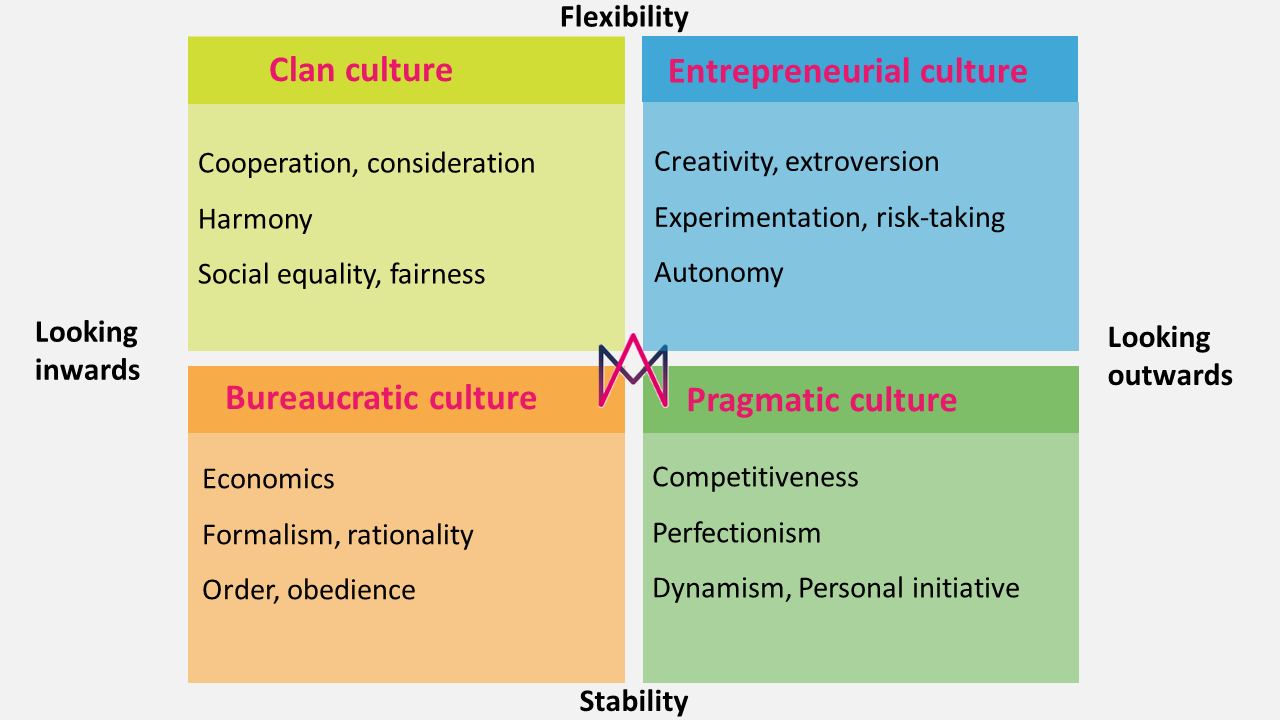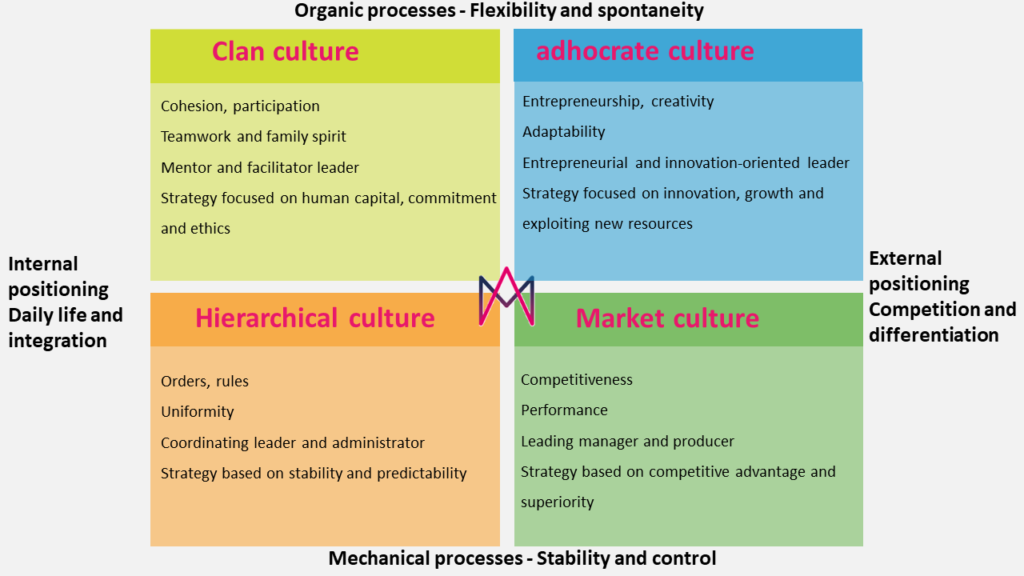Definition of corporate culture, corporate culture models and links between management styles used in companies today – Applied research

What is a corporate culture?
Over the last 30 years, a large number of definitions of corporate culture have emerged. Below are a number of models that have enabled us, as part of a Research and Development programme, to analyse the interactions between corporate culture and management styles.
Below, we develop a historical theory of corporate culture in the West, taken from the book on management offered by Assess Manager, and then detail 3 major corporate culture models selected as part of our research work to identify the links between corporate cultures and management styles.
4 major corporate cultures linked to our history
Evolution of corporate cultures in relation to the HBDI model
This theory is the result of research work carried out over 6 months at the Assess Manager research centre.
In its management tests, Assess Manager uses research from the Herman Brain Dominance Instrument, commonly known as HBDI, which is fairly close to the better-known DISC current, but less in tune with this perception of macro-cultural changes. Here are the main points(extract from the book Assess Manager on managerial skills). We identify 4 major historical periods, each with its own distinct corporate culture and associated management styles.
The war era – Culture of authoritarianism
If we go back to the period of the Second World War, we are living under regimes of emergency and totalitarianism. Army management is authoritarian, with little room for debate. Orders must be carried out without a word, and subordination is accepted as necessary. Information flows downwards. Executives are not asked to have emotions or to think.
This is directive management – advantages and disadvantages.
Post-war period – Culture of reconstruction and family values
After the 2nd World War, the era of reconstruction and the industrial era began. Productivity was the key driver of this era. Employees were guided by totalitarianism, and needed a direction embodied by a leader. But the leader had to want them well. Fordism and Taylorism launched the new trend with the imprint of the company manager who ran his business like a good father. He builds them a home.
The company is a second family, and it is within the company that families are created. The manager is a father figure whom you have to trust. He protects his employees, guides them in their lives, makes them loyal and proud to belong to the great house that is the company.
Advantages and disadvantages of the paternalistic model
May 68: the start of a new era in the distribution of power
The era of Fordism and Taylorism was followed by several events: May 68 in France in particular. These were echoed in other parts of the world: in Eastern Europe, in the United States, particularly in Chicago and South Carolina, in Canada, etc
It was students who initiated these social movements and ushered in a new era: a call for freedom of thought and action in opposition to the man-machine. They gradually gave rise to participative management. It is the gradual abolition of the dictatorship of the boss or the reign of the father, giving power back to employees and uniting teams by seeking to develop motivation, the new key to productivity.
Advantages and disadvantages of the participative model
A culture of responsibility and delegation of authority
Now comes the current era, which we have certainly been in since the financial crisis of 2008 or so, in which the watchword is a return to empowerment. Now that the participatory movement has reached its limits, we need to put responsibility back into the world of work. Faced with employees’ rights, duties were reaffirmed in various forms. This gave rise to delegative management, in other words the delegation of responsibilities.
What kind of corporate culture are we moving towards?
The only answer we can give is an a posteriori assessment of the virtues and limitations of each model. In this sense, won’t the manager of tomorrow be the agile manager, the one who knows how to adapt to situations and demonstrate the greatest agility, while at the same time having a greater mastery of ‘unitary’ managerial skills to avoid the pitfalls we have mentioned?
Is the corporate culture on the move one of variable geometry, fragmented and communitarian or clannish (Goffee and Jones model), entrepreneurial, a culture of change, a matrix and multi-dimensional culture, a complex culture?
Covid 19 is certainly changing the cultural dimension of the company, by restoring a form of solidarity between managers and employees, who are united in the face of a harmful external phenomenon. Or perhaps it will accelerate the atomisation of work units, notably through teleworking and physical detachment from the company…
To be continued… The corporate culture models below complete the analysis you have just read. This analysis, slightly modified from the original work, is an extract from the book on managerial skills.
Theoretical models of corporate culture
We have analysed the following models and we will detail the last 3 models presented:
- Ouchi’s A, J, Z model
- Trompenaars’ model of culture and nation
- Hofstede’s four cultural dimensions, Deal and Kennedy’s model of cultural profiles
- Handy’s Culture Model – The manager’s Olympus
- Goffee and Jones model
- Competing values model
- Cameron and Freeman’s tetra-factorial model
Corporate cultures: the Goffee and Jones model
The Goffee and Jones model, while including values in the description of each corporate culture, identifies a typology of leaders, values and a form of commitment.

The PROFIL-ER product (collective diagnosis) offered by Assess Manager identifies the major trends in corporate culture. This is the product that brings together all the results of the management test of your teams, and presents an analysis linked to the corporate culture.
Automated training plan – Target the needs of each manager and refine your analysis of your corporate culture.
Corporate cultures: Competing values model
The competing values model is based solely on the notion of values, which underpins and guides action in the company, human relations and the relationship with work.

Corporate cultures: Cameron and Freeman’s tetra-factor model
In the tetra-factorial model, strong emphasis is placed on the qualities of the leader and the strategy of the organisation, making it possible to define 4 major cultures.

The PROFIL-ER product offered by Asses Manager identifies the major trends in corporate culture. To find out more
Some lessons and observations on these corporate culture models
These three models, which are fairly representative of all corporate culture models, clearly show the importance of the values held by the company, as well as the type of market in which the company operates, the qualities of the leader who drives the structure and gives it a ‘colour’, and other factors.
It is easy to understand that corporate culture models are evolving rapidly, given the structural changes we are currently experiencing.
While it was easy to associate certain entities with the hierarchical culture model (Cameron and Freeman), in which we find equivalences with the bureaucratic culture model (competing values), we are now seeing a change in trends in companies:
Large companies are segmenting or subcontracting to increase their responsiveness (it’s quicker to turn around 5 dinghies than an ocean liner); civil service structures are seeking greater performance and opening up to the outside world; and business models based on dehumanised competitiveness are introducing the notion of quality of life at work.
In other words, traditional cultures are being shaken up and undergoing quite profound changes.
Structural changes in corporate cultures
The current structural changes will certainly give rise to new forms of integrated cultures, giving even greater prominence to the need to develop the adaptability of managerial qualities within the company.
In carrying out a research and development programme on the interaction between corporate cultures, management styles and managerial skills, we have found that :
- The culture perceived by individuals is sometimes very different depending on the department to which they belong
- If a global corporate culture is perceived, sub-cultures may emerge, in line with the development of networks within companies (clan or network concept)
- Certain corporate cultures tend to be less and less represented on the market
- The business world is undergoing significant change, accelerated by new technologies.
Discover Assess Manager solutions – Personality and Management tests – compare your leadership styles with the corporate culture in which you work:
Changing managerial qualities
As a result of the structural changes in corporate cultures outlined above, the managerial qualities sought in companies today also seem to be evolving:
- While paternalistic management has long been fashionable, those who practise it are increasingly aware that it is not enough and are tending to diversify their leadership qualities.
- While participative management may have had its heyday, it is now being revamped, with greater responsibility being given to teams and the integration of the delegative manager and manager-coach posture
- Although directive management has been widely decried, it is once again being rehabilitated in a growing number of companies where it has been lacking.
- There are fewer and fewer leadership styles to be favoured or “fashionable” in today’s business world, and certainly in the future. The qualities sought in today’s managers are increasingly linked to their ability to adapt. The indicators in the Assess Manager test, such as situational adaptability, intellectual adaptability and emotional intelligence, are therefore key elements, in addition to the indicators linked to pure managerial skills(ability to delegate, organise work, etc).
KEY POINTS
- Corporate cultures are changing, and a manager’s adaptability is becoming a key factor in managerial efficiency within the company
- The acceleration of change within the company, driven in particular by new technologies and the fragmentation of the organisation, is pushing managers towards excellence: the learning curve is getting shorter
- The management test identifies the manager’s key resources and areas for improvement. It enables us to target more quickly the manager’s needs in terms of efficiency, both in terms of posture and skills.
- As part of the Assess Manager package, you can identify the dominant corporate culture by means of the collective diagnosis offered in the “MyCampus Management” section

To go further with Assess Manager


